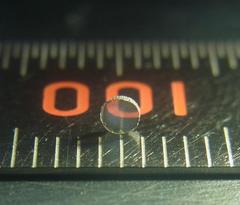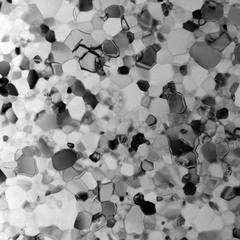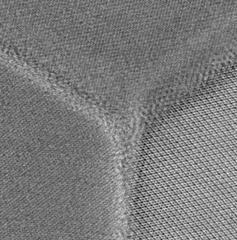URL: https://www.desy.de/news/news_search/index_eng.html
Breadcrumb Navigation
DESY News: Transparent ceramics make super-hard windows
News
News from the DESY research centre
Transparent ceramics make super-hard windows
Scientists have synthesised the first transparent sample of a popular industrial ceramic at DESY. The result is a super-hard window made of cubic silicon nitride that can potentially be used under extreme conditions like in engines, as the Japanese-German team writes in the journal Scientific Reports. Cubic silicon nitride (c-Si3N4) forms under high pressure and is the second hardest transparent nanoceramic after diamond but can withstand substantially higher temperatures.

A sample of transparent polycrystalline cubic silicon nitride, synthesised at DESY. Credit: Norimasa Nishiyama, DESY/Tokyo Tech
At pressures above 130 thousand times the atmospheric pressure, silicon nitride transforms into a crystal structure with cubic symmetry that experts call spinel-type in reference to the structure of a popular gemstone. Artificial spinel (MgAl2O4) is widely used as transparent ceramic in industry. “The cubic phase of silicon nitride was first synthesised by a research group at Technical University of Darmstadt in 1999, but knowledge of this material is very limited,” says Nishiyama. His team used a large volume press (LVP) at DESY to expose hexagonal silicon nitride to high pressures and temperatures. At approximately 156 thousand times the atmospheric pressure (15.6 gigapascals) and a temperature of 1800 degrees Celsius a transparent piece of cubic silicon nitride formed with a diameter of about two millimetres. “It is the first transparent sample of this material,” emphasises Nishiyama.

A bright-field transmission electron microscope image of cubic silicon nitride. The average grain size is about 150 nanometres (millionths of a millimetre). Credit: Norimasa Nishiyama, DESY/Tokyo Tech
Investigations with a scanning transmission electron microscope at the University of Tokyo showed that the high-pressure sample has only very thin grain boundaries. “Also, in the high-pressure phase oxygen impurities are distributed throughout the material and do not accumulate at the grain boundaries like in the low-pressure phase. That's crucial for the transparency,” says Nishiyama.
“Cubic silicon nitride is the hardest and toughest transparent spinel ceramic ever made,” summarises Nishiyama. The scientists foresee diverse industrial applications for their super-hard windows. “Cubic silicon nitride is the third hardest ceramic known, after diamond and cubic boron nitride,” explains Nishiyama. “But boron compounds are not transparent, and diamond is only stable up to approximately 750 degrees Celsius in air. Cubic silicon nitride is transparent and stable up to 1400 degrees Celsius.”

An atomic-resolution scanning transmission electron microscope image of a triple junction of grains in cubic silicon nitride. The thickness of the grain boundaries is less than one nanometre. Credit: Norimasa Nishiyama, DESY/Tokyo Tech
Tokyo Institute of Technology, Ehime University, the University of Bayreuth, Japanese National Institute for Materials Science, and Hirosaki University were also involved in this research.
Reference:
Transparent polycrystalline cubic silicon nitride; Norimasa Nishiyama et al.; Scientific Reports, 2017; DOI: 10.1038/srep44755



